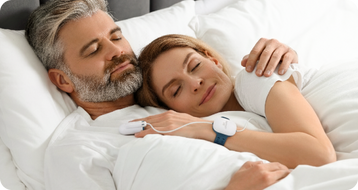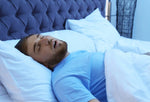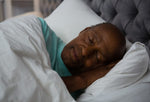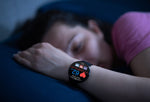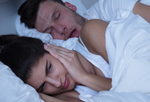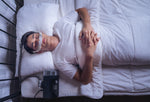On This Page
STOP-Bang Score for Obstructive Sleep Apnea
Our editorial process includes extensive measures to verify accuracy, provide clarity on complex topics, and present factual information. Read more
Key Takeaways
- The STOP‑Bang questionnaire is a quick screening tool with eight yes-or-no questions to estimate the risk of obstructive sleep apnea (OSA), but it does not diagnose the condition.
- A STOP‑Bang score can range from 0 to 8: A score of 0 to 2 indicates low risk, 3 to 4 intermediate risk, and 5 to 8 high risk of OSA.
- The questionnaire is good at detecting those likely to have OSA but generates a high number of false positives, so a high score doesn’t guarantee OSA.
What Is the STOP-Bang Questionnaire?
The STOP-Bang questionnaire is a screening tool used by health professionals to assess a person’s risk of having obstructive sleep apnea. It's typically used by doctors and other healthcare providers who aren't sleep specialists to help identify high-risk individuals. But it can't diagnose OSA. Diagnosis requires testing, typically in the form of a sleep study (polysomnography).
The STOP-Bang questionnaire asks eight yes-or-no questions about specific risk factors and symptoms of OSA. These form an acronym that give the questionnaire its name.
- S = Snoring: Do you snore loudly enough to be heard in another room or to awaken a bed partner?
- T = Tired: Do you regularly feel tired or fall asleep during the day?
- O = Observed: Has anyone observed you choking, gasping, or experiencing breathing interruptions during sleep?
- P = Pressure: Do you have high blood pressure?
- B = BMI: Do you have a BMI greater than 35?
- A = Age: Are you over the age of 50?
- N = Neck circumference: Is your neck circumference is greater than 16 inches?
- G = Gender: Were you born male?
What Does a STOP-Bang Score Tell You?
A person’s STOP-Bang score may be used to evaluate the chances that they have obstructive sleep apnea. To calculate the score, every positive answer on the STOP-Bang questionnaire is scored one point, then the points are totaled, yielding a score between 0 and 8.
| Score | Obstructive Sleep Apnea Risk |
| 0 to 2 | Low Risk |
| 3 to 4 | Intermediate Risk |
| 5 to 8 | High Risk |
The healthcare provider administering the STOP-Bang questionnaire may use the result to determine whether additional testing with a sleep study might be beneficial. The STOP-Bang score in itself cannot diagnose OSA.
When Do Doctors Use the STOP-Bang Questionnaire?
The STOP-Bang questionnaire is most often used when a doctor wants to quickly check your risk for sleep apnea before ordering more in-depth testing. You might see it during a physical exam, at a sleep clinic, or as part of a pre-surgical assessment where sleep apnea could affect anesthesia or recovery.
Diagnosing Obstructive Sleep Apnea
The STOP-Bang questionnaire is typically used as a screening tool to identify patients who are at risk for having OSA. The STOP-Bang is usually used by healthcare providers who aren't sleep specialists.
Preparing for Surgery
Doctors may use the STOP-Bang questionnaire to screen people who are having surgery. The STOP-Bang can help to estimate the likelihood that a person has undiagnosed OSA before surgery. This is important because people with undiagnosed OSA may be at a higher risk of complications during and after surgery.
Admitting to the Hospital
The STOP-Bang questionnaire is sometimes used during hospital admissions. Screening helps healthcare teams anticipate and manage potential breathing issues that could occur during recovery or while using sedatives or pain medications. If a patient screens at high risk, hospital staff may monitor their breathing more closely or adjust their treatment plan.
During Primary Care Visits
Doctors may also use STOP-Bang to screen for OSA in primary care settings. Because many people with sleep apnea go undiagnosed, the questionnaire offers a quick way to identify patients who report symptoms like loud snoring, daytime fatigue, or high blood pressure.
Is the STOP-Bang Questionnaire Helpful?
The STOP-Bang questionnaire is widely used because it’s a simple, evidence-based way to estimate the likelihood of sleep apnea. It’s especially helpful for identifying people who might otherwise go undiagnosed, but it’s most effective when used alongside other evaluations and diagnostic testing.
Benefits of the STOP-Bang Questionnaire
Research has shown that the STOP-Bang questionnaire has a high degree of sensitivity, which means that it's good at detecting OSA. For this reason, experts recommend that people with high scores undergo a sleep study.
One of the biggest advantages of the STOP-Bang tool is its simplicity. It can be completed in just a few minutes and doesn’t require specialized equipment, making it practical for use in doctor’s offices, hospitals, and even large-scale health screenings.
The questionnaire also helps identify people who might otherwise go undiagnosed, since many individuals with sleep apnea don’t recognize their symptoms or assume fatigue and snoring are normal. By flagging those at higher risk, STOP-Bang encourages early testing and treatment, which can lower the risk of heart disease, high blood pressure, and other complications linked to untreated sleep apnea.
Downsides to Using the STOP-Bang Questionnaire
However, the questionnaire also has low specificity, meaning that it produces a high rate of false positives. A false positive is when the test result is positive even though the test taker doesn't actually have the condition. False positives can lead to additional testing that's not needed.
One limitation of the STOP-Bang is that it gives equal weight to all risk factors for OSA. Research suggests that certain risk factors may be more predictive of OSA than others. Because of its limitations, experts recommend against the routine use of the STOP-Bang as a screening tool in people who aren’t experiencing any symptoms like daytime sleepiness, snoring, or gasping in their sleep.
The STOP-Bang also gives women a lower score than men, yet OSA becomes much more common in women during midlife. Because of this, some experts believe STOP-Bang scores should be interpreted differently in women.
Adjustments to the STOP-Bang Questionnaire
Due to the limits of the STOP-Bang questionnaire, several attempts have been made to make it more accurate and useful.
- STOP-Obesity: Because obesity is a significant risk factor for OSA, some experts believe body fat should be a stronger consideration in the STOP-Bang. An adapted questionnaire called STOP-Obesity assesses the risk of OSA by considering snoring, fatigue, observed sleep disruptions, high blood pressure, and body fat percentage.
- STOP-B28: The relative importance of risk factors like sex and BMI change as people get older. Therefore, a modified questionnaire called the STOP-B28 has been proposed for older adults, which disregards sex but shifts the BMI cutoff down to 28.
Alternatives to the STOP-Bang Questionnaire
While the STOP-Bang questionnaire is one of the most widely used screening tools for obstructive sleep apnea, several other assessments can also help estimate a person’s risk before formal testing.
- Berlin Questionnaire: This screening tool focuses on three main areas: snoring, daytime sleepiness, and the presence of high blood pressure or obesity. It classifies respondents into high- or low-risk categories for sleep apnea and is commonly used in both clinical and research settings.
- Sleep Apnea Clinical Score: This combines a patient’s symptoms and physical measurements—such as neck circumference, hypertension, and history of snoring—to estimate the likelihood of OSA. It’s often used in hospital or pre-surgical settings.
- Lausanne NoSAS Score: This tool uses five key factors: neck circumference, obesity, snoring, age, and sex. Each factor is assigned a point value, and higher total scores indicate a greater likelihood of sleep apnea.
- Multivariable Apnea Prediction (MVAP) Instrument: This estimates sleep apnea risk based on demographic and symptom data, including age, sex, body mass index, and frequency of snoring or witnessed apneas. It uses a mathematical formula to calculate a probability score.
Each of these tools provides valuable information, but none can replace a sleep study, which remains the only way to confirm an obstructive sleep apnea diagnosis.



